
One of the criteria you can use to measure success is if something stands the test of time. The Ace Aceliner model 502 was made for over 50 years with almost no changes. I think that qualifies as being very, very successful.
If you have one of these fasteners the reasons for its longevity become readily apparent. Solidly built, surprisingly heavy-duty, and dependable as death and taxes. If that’s all the Aceliner [note 1] had going for it you wouldn’t be surprised by its success. However, add in the unique styling and thoughtful ergonomics and what you end up with is one of the best looking, best built staplers ever made.

1941 magazine ad
There were a total of four plus versions of the Aceliner manufactured. The first versions all have the same specifics. Each weighs 1 pound 4 ounces and measures 7.75 inches long by 1.7 inches wide by 2.7 inches in height. They are made with all steel parts which according to literature was “triple-chromed”. There are also two rubber feet and a plastic handle. The handle was made of a plastic known as catalin as was the decorative plastic disc inside the push-rod head [note 2].
The 502 was advertised, and the bottom of the stapler states this as well, as needing Ace no 2025 or 20253 staples. However, the no 2025/20253 staple is exactly the same size as a standard-size staple so standard staples will work just fine. The magazine will hold a full strip of 210 staples. There is also a sliding anvil that will allow you to change between permanent and pin clinches. And of course you can use the Aceliner as a tacker by rotating the base 180 degrees.

1958 newspaper ad

1968 newspaper ad
One of the questions that often comes up in regards to the Aceliner is how to load it. The Aceliner is a rear-loading machine. To load, simply pull very slightly up and then out on the rear push-rod head. The head is the part on the rear that is a chrome round ring surrounding a colored plastic disc. Pull the rod all the way to the end and then swing it upwards. You can then insert your staples. Very easy once you do it once or twice. There is a button on each side of the body that when depressed allows you to lift the handle as you would with a standard stapler. However, you cannot load staples this way. The purpose of this feature is to allow access to the inside in order to clear jams or fix any issues that come up with the internal mechanism.
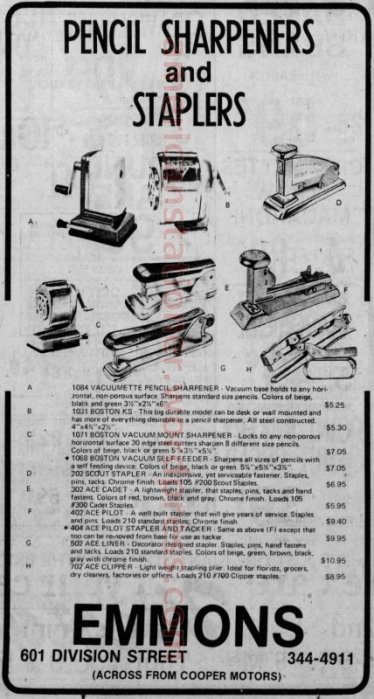
1975 newspaper ad

1981 newspaper ad
The Aceliner was advertised starting in 1941 through at least 1992. These were still being manufactured in 2001 and into the 2000’s but there is very little information about this. In total there were four plus known versions of the Aceliner. You can determine which version you have by using the following information:
- Version 1 (1941 – 1961) rounded smooth top, front of body is blank, has three patents listed on bottom of base plus “OTHERS PEND”
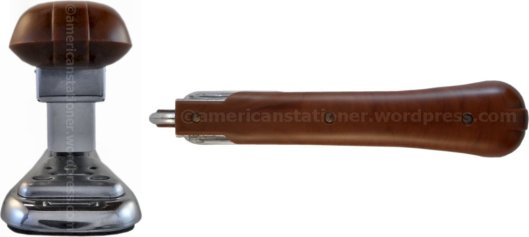
- Version 2 (1962 – 1971) rounded smooth top, “ACE” etched into front body, has four patents listed on bottom of base plus “OTHERS PEND”
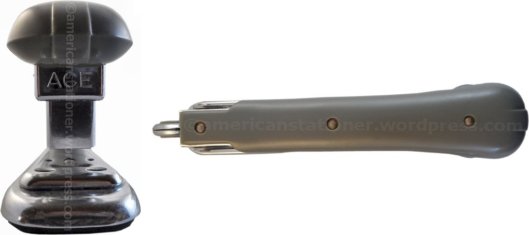
- Version 3 (1971 – 1992) scalloped top with rectangular inset with
 in script molded into it. “ACE” etched into front body. Along with this, later models of this version will state “USE ONLY ACE NO. 20253 STAPLES”.
in script molded into it. “ACE” etched into front body. Along with this, later models of this version will state “USE ONLY ACE NO. 20253 STAPLES”.
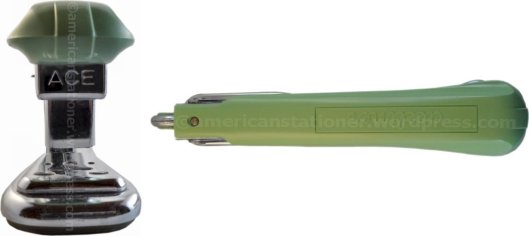
- Version 4 (approximately 2000’s) same styling as v3 but weighs slightly less at about 1 pound

I’ve also composed the following chart showing which handle colors are known to have been available in which years [note 3].
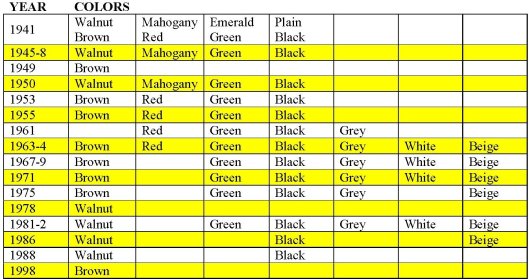
Chart Notes:
a) the color names used in 1941 were how they were originally listed by Ace. By 1945 all colors were identified by one word descriptions.
b) year gaps simply signify that I could find no advertisements, catalog listings, official Ace literature, etc. that mentioned available colors.
c) color gaps signify only that no reference could be found to that color in any literature, etc. for that year. In other words, it’s not only possible, but likely, that in 1949 you could purchase an Aceliner with a mahogany, green, or black handle. But nothing official has yet been seen to corroborate this. However, you probably wouldn’t have seen a grey handled Aceliner until 1961.
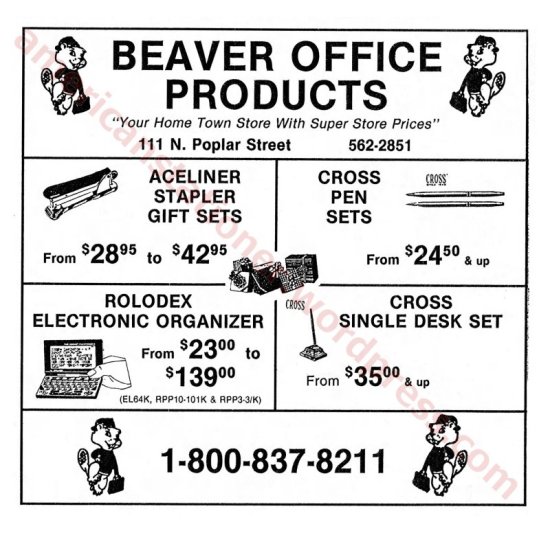
1992 newspaper ad
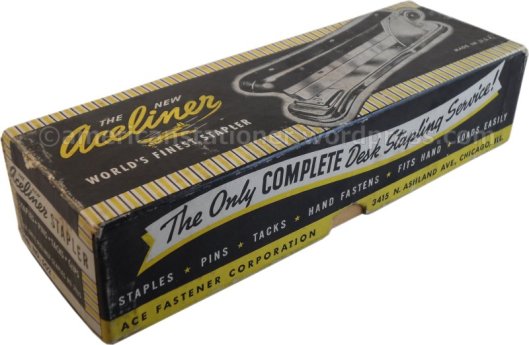
circa 1941 box
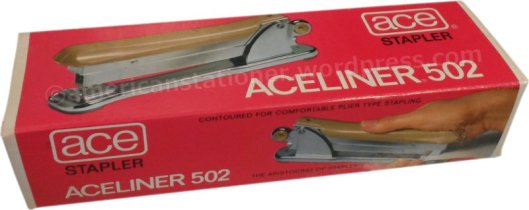
box from 1974-1981

box of Aceliner 2025 staples from 1940’s

box of Aceliner 2025 staples from 1960’s
UPDATE: In August 2021 I published my newest book Staplers, Stapling Machines, & Paper Fasteners Volume 3: Ace Fastener. In this book you’ll find a greatly updated write-up on the history of the model 502 Aceliner which includes info on all TEN versions of this stapler!
Patent and Other Information:
- Aceliner Stapler Instruction Sheet
- Patent 2059020 Stapling Device (filed 01/15/32, granted 10/27/36)
- Patent 2066157 Stapling Machine (filed 01/28/33, granted 12/29/36)
- Patent 2107169 Stapling Machine Core (filed 08/27/34, granted 02/01/38)
- Patent 2271926 Riser for Stapling Machines (filed 07/01/40, granted 02/03/42)
- Patent 2832959 Stapling Device (filed 08/25/55, granted 05/06/58)
- Design Patent 127378 Stapling Machine (filed 03/26/41, granted 05/20/41)
Notes:
- The correct spelling for the no 502 is “Aceliner” not “Ace Liner”. This two-word version probably came about due to the inscription on the bottom of the staplers. ACE was placed above LINER but that was simply due to space limitations.
- Even back in the earlier 20th century there were different types of plastic. It’s something of a pet peeve of mine when someone says that old plastic is “bakelite” simply because its old. It seldom is. You especially see this on online auction sites. It has pretty much the same standing meaning-wise as words such as “rare”, “antique”, “vintage”, and “art deco”. All these terms along with “bakelite” are essentially meaningless on auction sites.
- This chart was compiled using advertisements from periodicals, newspapers, office supply catalog listings, government records, and from official Ace Fastener Corp. marketing materials.
- Ace Fastener Corp., (1941, June), advertisement. Geyer’s Topics, page 41
- Utility Supply Co Catalog (1945), Chicago, IL, page 383
- Paulin’s Inc., (1958, March 28), advertisement. The Latrobe Bulletin, page 9
- Ace Fastener Corp. (1962), Ace Staple Selector [brochure], Chicago, IL, Ace Fastener Corp.
- Ace Fastener Corp. (1963), Ace World’s Finest Stapling Machines and Staples… [brochure], Chicago, IL, Ace Fastener Corp.
- Turner Office Equipment, (1968, February 29), advertisement. The Lancaster Eagle-Gazette, page 17
- Shirley Office Supply Catalog (1975), Pennsauken, NJ, page 199
- Emmons, (1975, July 16), advertisement. Stevens Point Daily Journal, page 18
- Halsey & Griffith, (1981, January 27), advertisement. The Palm Beach Post, page A5
- Office of the Federal Register, National Archives and Records Service, (1982, October 12), Appendix A Price List ACE. The Federal Register, page 1067 (45994)
- Beaver Office Products, (1992, December 3), advertisement. The Bucyrus Telegraph-Forum, page 8
Visit me at http://www.facebook.com/americanstationer and let’s get nerdy about office supplies 🙂
If you enjoy the American Stationer consider purchasing one of my books at Amazon.
- STAPLERS, STAPLING MACHINES, & PAPER FASTENERS VOL 1 – E.H. HOTCHKISS COMPANY OFFICE AND INDUSTRIAL STAPLING MACHINES
- STAPLERS, STAPLING MACHINES, & PAPER FASTENERS VOL 2 – NEVA-CLOG
- NEVA-CLOG STAPLING MACHINES PRICE GUIDE: 2019 EDITION
You’ll get one-of-a-kind references and information you won’t find anywhere else and you’ll help me keep American Stationer going.

Excellent research – I had it exactly backwards which style was older. Time to update my blog post on the Aceliner, thanks! (:
LikeLiked by 1 person
Thank you for this post! My wife has a version one that she inherited from her father, and we’ve been trying to find “2025” staples for it. We also figured out the right way to load it once we realized we had usable staples.
LikeLiked by 2 people
I have a similar problem I didn’t know how to load it I thought I needed smaller staples oh my gosh thank you thank you thank him for this explanation and for another person who had the same problem!
LikeLiked by 2 people
We love our old Aceliner stapler but recently it has been flattening the staples and turning them outward, not inward. Are we using the wrong staples or is there a setting on the stapler we can change? Thanks in advance for your help!
LikeLike
You’ve accidentally pushed the anvil back and it’s now set in the pinning position. Push it forward and it will be “fixed”.
LikeLike
Mine to what’s the anvil?
LikeLike
It’s on the top forward part of the base where you staple
LikeLike
Hi I posted yesterday about my 502 being jammed. Cleared that up however unable to staple. Hard to depress and the first staple is mooched ( technical term). Any ideas?
Thanks
LikeLike
There are two buttons, one on each side of the body. Depress them both simultaneously and the top will pop up. You should be able to remove any broken or stuck staples.
LikeLike
I’ve got three Aceliner staplers I bought together as part of a larger lot of used staplers. They don’t match any of your four versions, and appear to fit in between versions 3 and 4. The engraving on the bottom says “USE ONLY ACE NO. 20253 STAPLES MADE IN USA” but unlike my other Aceliners, there is a seam in the staple tray on the front (below the “ACE” inscription) and not on the underside of the staple tray. Also, the push rod is not held captive like my older Aceliners, but is easily removed when one is loading staples. There are some other differences, but those are the main ones.
I don’t have a scale handy, so I cannot confirm that these are the same weight as your Taiwan-made version 4 (although the redesign appears to use less metal), but they are marked as made in the USA. I’ll try to take some photos so you can see the differences.
LikeLike
The 20253 staples thing is from a late model version 3. I also have push rods that can be completely removed but the jury is still out on if that is purposeful from Ace or not. I’d love to see the pics. The seam on the front of the magazine is very likely a late change to the model 3 as it would allow the use of cheaper pressed metal designs. We’re all learning together and I love this kind of feedback!
LikeLike
Here are the photos (if this lets me post a link): https://imgur.com/a/GB2mAtL
I kept my five Aceliners in the same order in all the photos; from left to right, version 1 in black, early version 3 in tan, and three of the late version 3 (version 3.5?) in walnut, black, and a darker tan. I discovered there are number codes in the side of the staple tray, visible once the top is opened. There’s no code on the version 1, “471” on the early version 3, and “389”, “389” & “278” on the other three. These are constant with a month & year date code, but this is too small of a sample to be certain of that.
Engraving aside, these are the differences in the three “new” version Aceliners:
1) Staple tray construction, with the “interlocking puzzle piece” seam on the front, and no seam on the underside.
2) Different rubber feet, attached with a different sort of rivet.
3) Hole on the side of the staple tray, letting one see if staples are loaded.
4) Pusher rod is not captive. The track that allows the captive pusher rod to be pulled up and out of the way when loading staples is completely missing.
LikeLike
I happened upon this post while searching for 2025 staples for my model 502. Can’t find them anywhere. Do you have a source? Many thanks and very interesting post!
LikeLike
Ok, nevermind. I knew I needed to load from the back as you posted above, but had no idea a standard staple will work. Problem solved!
LikeLike
I’ve done everything you showed on your video and it still doesn’t work!
LikeLike
ummmm, I don’t have any videos. Where did you see it?
LikeLike
Just picked up a grey v3 at a flea market visit today. Thanks for compiling this information.
LikeLike
Where can I find staples for my dad’s stapler model 502?
LikeLike
Literally everywhere. The Aceliner uses standard staples.
LikeLike
Looks like they may still be available. Mine is a Emrald Green V-4.
http://www.acefastener.com/aceliner.html
LikeLike
I am having a unique problem. I load the staples into my version 3, but the plunger mechanism will not push forward to push the staples. It stays extended out the back about a quarter of an inch. This happened once before, then it just slid in on one try. I can’t determine why it
is not advancing forward. Can you help???
LikeLike
Sounds like poor quality staples. Remove what’s in there and try something different
LikeLike
Actually, I turned it upside down (front down – back up) and set the bottom to open. Then suddenly the lever slid in! And these are the same staples I have been using for years.
LikeLike
I have a #1 which I knew was at least 50 years old, but now I know it’s over 60. It was my father’s and on his desk where he was general manager of the Pilot Insurance Company in Toronto for many years, retiring in 1968.
It still works better than any other I’ve ever had, and feels so good in hand.
LikeLike
Thank you for saving my stapler from the trash. My Dad could not, for the life of him figure out how to load the stapler. We managed to open it, only to become more frustrated. Once I found this site I realized the back part had been smashed down a bit and stuck. After I used a small flat head screwdriver I was able to open it and load in some staples. It works very well now. Thank you for the detailed page!
LikeLike
I have an aceliner model 502 which says use only ace no. 2025 staples but standard staples are a bit to big to fit in track. Where do I buy staples? Is there something wrong with it?
LikeLike
I just figured it out….staples are inserted from back not top.
LikeLike
When I left my first job as a professional 1955 – 1969 I took the 502, oldest model per your chart, with me. I used it in a series of jobs until retirement and use it at home now. Would not be without it. Still love it. Walnut handle. A beauty! Never a problem.
LikeLike
My over 30 year old 502 worked fine, but suddenly staples refuse to slide all the way forward. Have used the same staples for years and they slide easily, but not to the very front. There is nothing jammed in the stapler. Any thoughts?
LikeLike
It’s impossible to say without seeing it, but the two most likely issues are a spent spring or a tiny divot in the rail. Try a little machine oil on the rail and see if that works. You may need to replace the spring and if so you will likely have to procure a donor machine and take the spring from there.
LikeLike
I had the same problem. I remember turning it on its end, head down, and trying gently to install the staples. All of a sudden it was working correctly. I think maybe something was blocking the staples from advancing all the way.
LikeLiked by 1 person
I only have one doubt, the catalog says that it can remove the staples, but I don’t understand how it does it, or what part is used for this.
LikeLike
The Aceliner does not have a built-in staple remover. Which catalog says that?
LikeLike
in the second image of this publication, in the boxes it mentions, staples, tacks, pins, hand fastens and staple remover.
LikeLike
If you read closely you’ll see that the staple remover is a separate item.
LikeLike
Thank you for this great website! I have version 4 of this great aceliner stapler.
I tried to load a new set of regular staples from the front, lifting the top up. To my dismay, the staples didn’t fit. Now I learn to refill from the back! Yay! What an easy operation. Thanks again!
LikeLike
My “Aceliner” 502 black with 3 patent pending, was my fathers. He was in the Michigan State Police from 1940-1967. On his desk (seems like forever) approx 20 years +/-, and in retirement til his passing in 1983, now it’s on my desk.
LikeLike
Does anyone have good pictures of the Model 1 with both the Brown and Mahogany? I have recently acquired one but it could be either color to me.
LikeLike
I have an Aceliner 502 which worked fine with standard staples for about 25 years until 1 day the staples and the end of the push rod refused to move all the way forward. I can force the push rod forward without the staples, but not with the staples. The push rod is removable.
I’ve checked numerous times, even probed with dentist’s tools, there is nothing blocking the staples.
Is it possible that a buildup of the staple adhesive is the problem?
Coincidently, another brand stapler that uses the same staples which I’ve always used is exhibiting the same problem. Any ideas why and how to fix it?
LikeLike
Without seeing the actual stapler it’s difficult to diagnose. I don’t believe it is caused by the adhesive. However, consider changing staple brand to one of the more mainstream brands like Swingline. These older staplers were designed with slightly thicker wire staples than you currently find, especially in the off-brands. You can also press the button on the side of the body to lift the handle and take a look inside to see if there is any debris or stickiness on the rails.
LikeLike
I inherited the aceliner 502 from my father when he passed away. He was a hardware man for years while I became a teacher. I had every Swingline stapler and several off-brands that never worked. My father had this stapler and I’m sure my mother used it too. Oh, had I had this one…trusty, made of steel, tool, I would only have needed one forever. It’s amazing all the tools that have been produced in the last 50 years that don’t hold a candle to this stapler. Bravo America for creating a tool that has lasted the test of time!
LikeLike
I have an Aceliner 502 I’ve had for 47 years and used every day at work et al. Color is I would assume mahogany brown. Stapler is like new never been damaged, etc. For some reason when stapling pages the staple ends on the back side of the pages are flared out and not toward each other as typically done. I use Swingline stapes, #35108. Any suggestions?
LikeLike
Yes, simply slide the anvil forward.
LikeLike
I inherited one of these staplers from my dad’s office things. I absolutely love it! Thanks for all the history. I sure appreciate your post. Very good and very interesting!!!
LikeLike